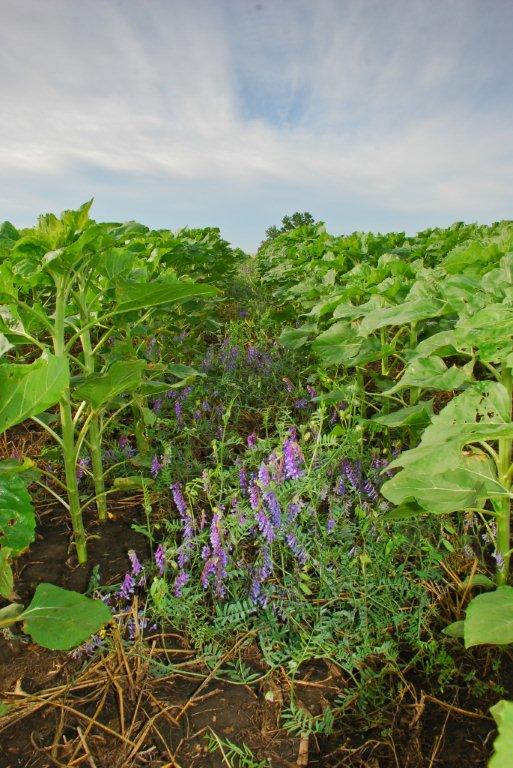Harmonized policies pertaining to cover crops and federal crop insurance may be in place this fall in time for the 2014 growing season and could encourage more cover-crop adoption.
A special USDA task force plans to issue “harmonized” cover-crop rules later this year to eliminate conflicts around crop-insurance policies and potentially remove a significant barrier to cover-crop adoption.
|
|
The “Task Force To Harmonize Cover Crop Policies” was created earlier this year after the USDA acknowledged the Natural Resources Conservation Service, Risk Management Authority and Farm Service Agency all have conflicting directives about cover cropping.
Along with the lead agencies, the National Association of Conservation Districts, National Wildlife Foundation and the American Soybean Association are also players on this task force.
Some official language may be in place this fall for the 2014 growing season in time for farmers seeding winter wheat, says Ryan Stockwell, ag program manager for the Washington D.C.-based National Wildlife Federation, which has been coordinating the effort among cover crop stakeholders to rectify policy barriers to cover crop adoption and provided guidance to the interagency task force.
Rules Stifle Adoption
The process to address the confusion created by the USDA’s conflicting rules actually began in January, when the NWF brought Emporia, Kan., no-tiller Gail Fuller to Washington.
Fuller — recently named by the ASA as a Conservation Legacy Award winner —experienced a delayed termination of his cover crops last year due to extended periods of high winds that prevented him from spraying.
He planted soybeans and other cash crops on his 1,800-acre farm before terminating his mix of cover crops, which was left growing from a few days to 2 weeks after planting. He lost his crop-insurance coverage after he was chosen at random for a post-planting inspection during the summer.
“His yields were the same as his neighbors’ yields. So during the worst drought in 50 years, he lost his crop insurance,” Stockwell says.
Work Begins
The longtime grain and livestock farmer became the poster child, of sorts, for government policies on cover crops running amok.
While the RMA has taken a strict stance on cover-crop termination dates, the NRCS, in contrast, has been encouraging cover-crop use and paying some farmers to use them to improve soil health, control erosion or help clean up polluted watersheds, Stockwell says.
In March, the USDA agencies examined their individual policies on cover crops and began to pore over peer-reviewed science on the impacts and management of cover crops.
Research was requested on water use of cover crops and soil-moisture availability of the subsequent insured crop; impact of covers in weed and disease management; and the yield impact on subsequent commodity crops.
Then the group began addressing conflicting definitions of different agencies, such as the definition of double-cropped acres vs. a cover crop, or cropping years, trying to make them as similar as possible while maintaining the legal requirements of different agencies.
Coming up with guidance to address the “coverage cliff” that Fuller experienced was a major goal for National Wildlife Federation and its partners. Stockwell says farmers frequently point out the lack of familiarity with cover crops on the part of initial insurance agents and adjusters.
“For us, current polices don’t reflect true risk associated with a cover crop getting a little too tall,” Stockwell says. “The problem may not be management decision, but a weather issue.
"We’ve had guys with long-term no-tilled fields cutting ruts in the mud to spray cover crops quickly so they’re not out of compliance with the RMA..." — GAIL FULLER |
“The big question is allowing that flexibility for farmers to manage cover crops to meet specifications of the growing year. Rather than having a hardened date for termination, should we have a policy that recognizes some years are dry and hot and you should terminate early, while other years it will be wet and you can let it go a little longer?”
It looks as though the federal government’s solution will center on geography. Stockwell says the NRCS used wind-water erosion modeling and precipitation-efficiency index models to come up with suggestions based on geographic areas and erosion and precipitation data.
That produced recommendations for cover-crop termination deadlines for four areas across the U.S., based on prevailing moisture levels.
“Those recommendations say that in the driest parts of the nation, you should terminate a cover crop 35 days before planting an insured crop. Where moisture is slightly more plentiful, it goes down to 15 days,” Stockwell says. “Termination at planting is allowed in another zone, and terminating a cover crop before the insured crop emerges is recommended in areas with plentiful moisture.”
The next step is for the RMA to draft specific language on policies to reflect those suggestions, “or they may come up with something different,” Stockwell says.
Future Discussions
Stockwell, who is actually working with cover crops as he transitions a small farm in Wisconsin to no-till, says this entire effort will have some long-term benefits as well.
The findings should direct more specific questions to crop researchers and help farmers evaluate specific cover crops to use in their rotations, he says.
The task force found there is plenty of cover-crop research out there, but much of it doesn’t address the risk factor, or yield impact to subsequent cash crops.
Behind The Times
Fuller’s story begins last August, when his name was randomly pulled for a growing-season inspection.
He thought he’d passed the initial inspection that month, but his case was sent up for review with the agent’s superior, an apparently his use of cover crops raised some red flags.
“They asked me lots and lots of questions, didn’t tell me what they were looking for and just kept asking more questions and finally said they would review it,” Fuller said Tuesday.
Last October, the company disqualified him from crop insurance on seven fields because of supposed “interplanting” practices where his cover crops were involved. Another soybean field was disqualified for general farming practices because of failure to control weeds.
Fuller says the weather was so dry that the soybeans didn’t establish and the mix of glyphosate, 2,4-D and Prefix didn’t seem to work on the weeds. A flush of weeds returned in summer and he didn’t spray them, per the advice from a letter he received from his custom applicator.
For the seven fields disqualified for interplanting, Fuller says the insurance company was using a rule that wasn’t written for cover crops and was being misinterpreted. It’s common practice in his area to plant cash crops first and then spray covers crops because that usually provides the best termination results, he says.
But last year, temperatures were in the 90s and 100s during soybean planting. Two weeks with winds gusting over 40 mph kept him from spraying, and custom applicators were already tied up and unavailable.
“I didn’t understand the rules and continued to do what I’ve done in the past,” Fuller says.
Little Or No Data
Fuller described how he talked with a top official at the Kansas RMA office and was told they had data on his region that served as a basis of their decision. When Fuller asked to see it, the office acquiesced.
Fuller says he received a PowerPoint presentation from a University of Nebraska Extension agent containing no scientific data and only a single line mentioning that cover crops can use water. Another document came from a Kansas State University agronomy newsletter discussing cover crops and timing issues, but it also had no data, Fuller says.
A third document from the USDA Agricultural Research Service in Akron, Col., contained some scientific data on a research project from the mid-1980s involving a monoculture of cover crops, Fuller says.
“Those are the things they’re using to dictate millions of dollars — yes or no,” Fuller says. “I talked to the authors. One had no idea they were using his information and he sent me a letter backing my stance. Another author told me their work was being taken completely out of context and it wasn’t relevant to eastern Kansas.
“When we’re using PowerPoints to dictate rules and regulations, something isn’t right,” he says. “The RMA in Washington told me I got caught in a trap set for farmers that are fraudulent in crop insurance. It wasn’t set for me, but I got my foot caught in it.”
In January, through the support of the NWF and other groups, Fuller met with directors of the RMA and NRCS and several representatives of Congress and discussed his situation. Among other things, he pointed out that he was awarded am NRCS Conservation Innovation Grant to work with cover crops and livestock, but that field was one of those disqualified by the RMA for insurance.
“We’ve got three government agencies controlling production ag and none of them are on the same page, and that needs to stop. You need to pick a direction,” Fuller recalls saying. “We can’t be getting paid here for one practice, then walk across isle and get denied for doing the same thing.”
Changes Coming
The same month he was in Washington, Fuller appealed the insurance decision through mediation and was denied, without explanation, in March. The next step is filing for arbitration with the American Arbitration Association, which appoints someone both sides agree on to hear the case.
Depending on what happens, it could be 20 months before Fuller’s insurance denial is completely settled.
“What they’ve done to the soil-health movement is inexcusable,” Fuller says. “We’ve got producers just loving what we’re doing here, but they’re scared to try cover crops, thanks to the RMA. We’ve had guys with long-term no-tilled fields cutting ruts in the mud to spray cover crops quickly so they’re not out of compliance with the RMA.
“But the response I got from Washington was unbelievable. I think there will be some huge changes.”

 A task force of govenment agencies was created earlier this year after the USDA acknowledged the NRCS, RMA and FSA have conflicting directives about cover cropping.
A task force of govenment agencies was created earlier this year after the USDA acknowledged the NRCS, RMA and FSA have conflicting directives about cover cropping.



Post a comment
Report Abusive Comment